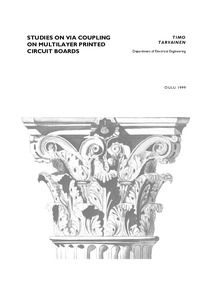Studies on via coupling on multilayer printed circuit boards
Tarvainen, Timo (1999-03-23)
Avaa tiedosto
https://urn.fi/URN:ISBN:951425189X
Kuvaus
Tiivistelmä
Abstract
Design and manufacturing techniques of printed circuit boards (PCB’s) have advanced from early one or two-layer structures to the multilayer boards where ten or more layers are no longer uncommon. These give additional routing space, potential decrease in device size and various design possibilities like solid ground and power planes. Unfortunately multilayer boards are vulnerable to high coupling between signal vias especially due to PCB resonances.
In this study via crosscoupling is investigated on multilayer PCB’s. Special attention is given to the coupling due to resonances and vertically aligned blind vias. Problem is approached from the electromagnetic compatibility (EMC) point of view andhigh accuracy of measurements or models is not the objective. Instead ways to increase isolation are considered important. EMC is considered to include internal functionality of the device.
Analytical methods are used to calculate resonant frequencies, fields and quality factors for simple rectangular structures. The PCB cavity is reduced to two-dimensions for numerical calculation of same quantities. Aplac finite-difference time-domain simulator is used to model coupling due to PCB resonances. Isolation between vertically aligned blind vias is estimated analytically. A quasi-static numerical model is used to study a coaxial via structure. Multilayer test boards are constructed for measurement purposes. Simplified resonator structures on two-layer boards are used to test different methods to increase isolation.
Measurements show that high coupling between vias may occur due to PCB resonances. This leads to the situation, where previously used isolation methods between vias are not necessarily effective enough. Several means to reduce effects of PCB resonances are described in this study. Measured and modelled results agree well from an EMC point of view. Coupling due to vertically aligned blind vias is also shown to be high. A simple capacitance model may be used to approximate this up to frequencies where the dynamic wave nature of the board starts to be important. From a PCB designer’s point of view these results mean that when the board size is not small compared to the wavelength, there is a possibility of resonances and reduction methods have to be taken into account. Also placement of the vias have to be carefully selected especially if blind or buried vias are used.
Kokoelmat
- Avoin saatavuus [32110]
